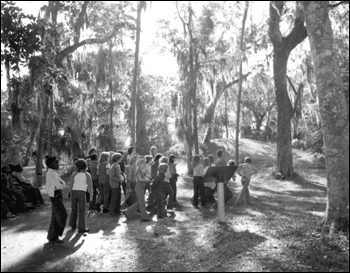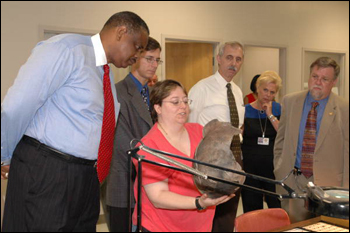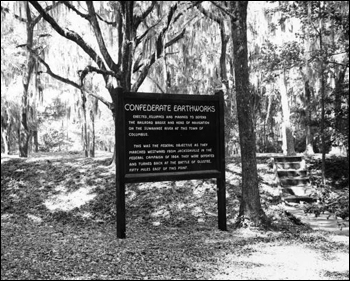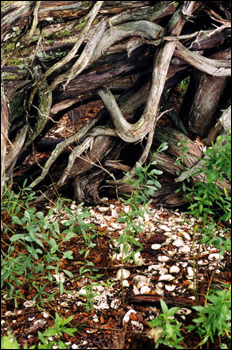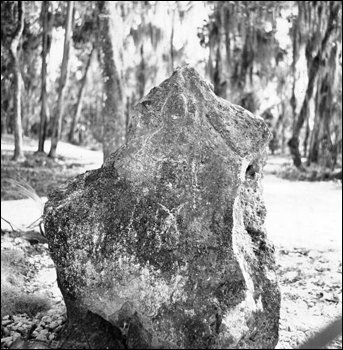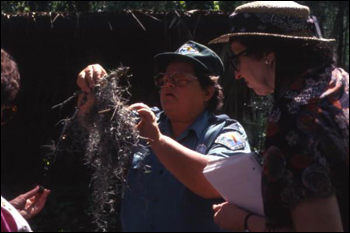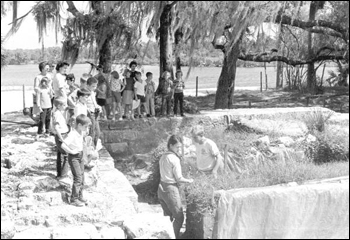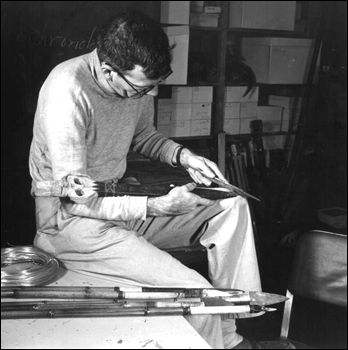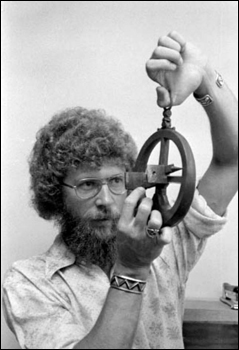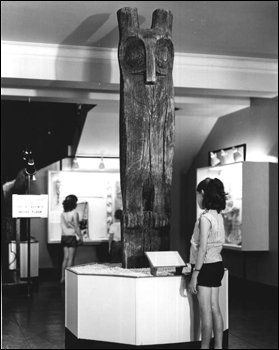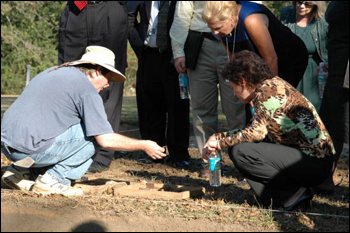Photo Exhibits
Photo exhibits spotlight various topics in Florida history, and are accompanied by brief text intended to place selected materials in historical context.
Florida Archaeology
Studying and Exploring 12,000 Years of Floridians
Public Resource
The majority of archaeologists are employed by government agencies, such as the Bureau of Archaeological Resources, the Department of Interior and the Florida Park Service. Consequently, public and political understanding of and commitment to archaeology are crucial to continued support for research and interpretive facilities and the maintenance and preservation of established and future sites for public access.
Visitors viewing the Indian mounds at Crystal River Archaeological State Park (1975)
Image Number: C683180
Indian pot being shown during Senate Committee on Governmental Oversight and Productivity tour of Mission San Luis : Tallahassee, Florida (2005)
Image Number: PR20386
The piece of pottery being reassembled is dated from between 1656 and 1704 (the dates that Mission San Luis was occupied).
Archaeologist Dave Dickel talking to members of the House Transportation and Economic Development Appropriations Committee during a tour of the R.A. Gray building (2005)
Image Number: PT04891
Included in the image are: Rachel Watson, Rep. Donna Clarke, Rep. Gus Bilirakis, Rep. Don Davis, Rep. Dick Kravitz, Lynne Overton, Administrative Assistant Shelby Bishop, Dave Dickel.
Interpretive sign at Suwannee River State Park : Madison County, Florida (196-)
Image Number: FPS1267
The sign reads: "Confederate Earthworks. Erected, equipped and manned to defend the railroad bridge and head of navigation on the Suwannee River at the town of Columbus. This was the federal objective as they marched westward from Jacksonville in the federal campaign of 1864. They were defeated and turned back at the Battle of Olustee, fifty miles east of this point."
Native American shell midden on south-west end of Big Talbot Island State Park : Jacksonville, Florida (1999)
Image Number: PR24700
The photographer was a park ranger at the park. The archaeological site was located directly across the Fort George River from Kingsley Plantation. The middens are the remains of the St. Johns culture (Timucuan peoples), and was perhaps related to the Spanish mission Sarabay (the original Spanish name of the island.)
Limestone stele (Stele #1) at Crystal River State Park : Crystal River, Florida (196-)
Image Number: FPS00137
In 1964, archaeologist Ripley Bullen discovered this limestone ceremonial stone (stele). While not all agree with his interpretation, Bullen believed this was purposely erected for ceremonial and celestial purposes. Located 75 yards east of the main burial complex, it dates to 440 A.D. A drawing of what Bullen believed was a human can be seen in this image.
Museums and parks are where people most often encounter the work of archaeologists, and these facilities are essential to making knowledge of a region's historic and pre-historic past tangible and meaningful for the public. Parks and museums also help illustrate to the public the importance of scientific study, as well as the preservation of unique and fragile resources. According to the Florida Department of Environmental Protection, there are more than 1,500 preserved archaeological sites in Florida state parks alone.
Florida Park Service Environmental Protection employee showing Spanish Moss to visitors during tour at the Hernando de Soto State Archaeological Site : Tallahassee, Florida.
Image Number: COM00318
State archaeologists, led by Calvin Jones, found pig bones, pottery, coins, Spanish chain mail and beads that identified the site where Hernando de Soto and his army spent the winter of 1539. To date, this is the only verified site for the entire DeSoto expedition. The State of Florida purchased the site in 1988.
Archaeologists showing children excavated ruins of Fort San Marcos de Apalache (1965)
Image Number: RC16747
Archaeologists show school children the excavated ruins of the "bombproof". Stone walls are the foundation portion of the "bombproof", which was 100 feet long and about 30 feet deep. It consisted of four vaulted rooms 15 feet high.
Hale Smith of FSU Anthropology making Atlatl (c. 1955)
Image Number: PR04408
Hale Smith was the chairman of the FSU Anthropology Department. He conducted several excavations throughout the state and the southeast. He published along with John Griffin the landmark book "Here They Once Stood", a 1951 study of Spanish missions in Florida, focusing primarily upon Mission San Luis.
W. A. "Sonny" Cockrell demonstrating an astrolabe
Image Number: PR12561
Marine archaeologist, W. A. "Sonny" Cockrell, demonstrates the use of an astrolabe, a 16th century navigation instrument found in one of the treasure ships sunk off Florida's coast.
Park rangers, museum professionals, and archaeologists from state and federal bureaus not only perform the important work of excavation and conservation, but they also interpret archaeological resources for site visitors and create educational materials, including everything from trail markers and outdoor signage to pamphlets, artifact displays, brochures and in-depth books.
Now the ever-growing number of educational materials created by archaeologists includes interactive Web sites that allow students to explore previously inaccessible areas of archaeological significance.
Timucuan horned owl totem pole : De Land Region, Florida (1955)
Image Number: RC17122
Made about 1350 A.D. out of pine. Found and dredged from the St. Johns River near DeLand, by Victor Roepke, in 1955.
Mission San Luis archaeologist Jerry Lee showing work to Senate Committee on Governmental Oversight and Productivity tour members : Tallahassee, Florida (2005)
Image Number: PR20393

 Listen: The Bluegrass & Old-Time Program
Listen: The Bluegrass & Old-Time Program